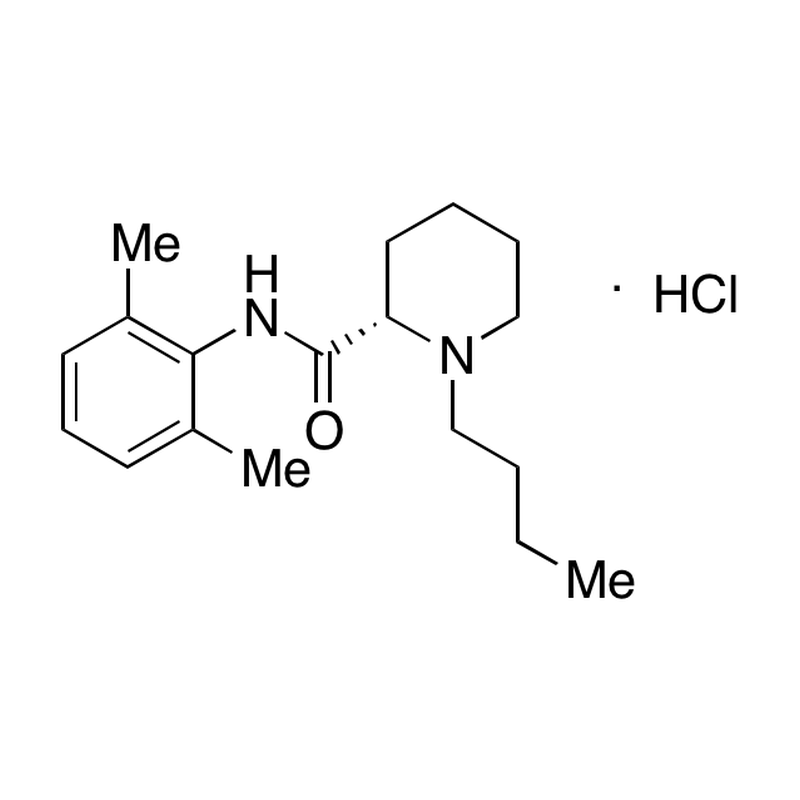产品
编 号:F301269
分子式:C18H29ClN2O
分子量:324.89
分子式:C18H29ClN2O
分子量:324.89
产品类型
规格
价格
是否有货
10mM*1mL in DMSO
询价
询价
5mg
询价
询价
10mg
询价
询价
50mg
询价
询价
100mg
询价
询价
200mg
询价
询价
500mg
询价
询价
结构图

CAS No: 27262-48-2
产品详情
生物活性:
Levobupivacaine hydrochloride ((S)-(-)-Bupivacaine monohydrochloride) is a long-acting amide local anaesthetic. Levobupivacaine hydrochloride exerts anaesthetic and analgesic effects through reversible blockade of neuronal sodium channel. Levobupivacaine hydrochloride can inhibit impulse transmission and conduction in cardiovascular and other tissues, possessing certain cardiac and CNS toxicity. Levobupivacaine hydrochloride is metabolized by hepatic cytochrome P450 (CYP450) enzymes in vivo. Levobupivacaine hydrochloride can also induce ferroptosis by miR-489-3p/SLC7A11 signaling in gastric cancer.
体内研究:
Levobupivacaine (40 μmol/kg; IP; once daily for 25 days) significantly inhibits SGC7901 cell growth, and enhances the lipid ROS accumulation.Levobupivacaine (5 or 36 mg/kg; IP; single dosage) increases the latency to partial seizures and prevents the occurrence of generalized seizures at low dosage; reduces the latency to N-methyl-d-aspartate (NMDA)-induced seizures and increased seizure severity at high dosage.Animal Model:CD1 mice (30-35 g; induced epileptic seizures by injecting with NMDA)
Dosage:5 or 36 mg/kg
Administration:IP; single dosage
Result:Increased the latency to partial seizures and prevented the occurrence of generalized seizures at 5 mg/kg; reduced the latency to NMDA-induced seizures and increased seizure severity at 36 mg/kg.
Animal Model:SCID nude mice (6-8 weeks; subcutaneously injected with 5×106 SGC7901 cells)
Dosage:40 μmol/kg
Administration:IP; once daily for 25 days
Result:Significantly inhibited SGC7901 cell growth, and enhanced the lipid ROS accumulation.
体外研究:
Levobupivacaine (0-4 mM; 24 h) does not affect the viability of GES-1 cells but inhibits the viability of HGC27 and SGC7901 cells.Levobupivacaine (2 mM; 24, 48 or 72 h) enhances Erastin-induced inhibitory impact on HGC27 and SGC7901 cell viabilities; induces the levels of Fe2+, iron, and lipid ROS.Levobupivacaine (2 mM; 24 h) enhances the expression of miR-489-3p in HGC27 and SGC7901 cells, increases the levels of Fe2+ and iron.
Levobupivacaine hydrochloride ((S)-(-)-Bupivacaine monohydrochloride) is a long-acting amide local anaesthetic. Levobupivacaine hydrochloride exerts anaesthetic and analgesic effects through reversible blockade of neuronal sodium channel. Levobupivacaine hydrochloride can inhibit impulse transmission and conduction in cardiovascular and other tissues, possessing certain cardiac and CNS toxicity. Levobupivacaine hydrochloride is metabolized by hepatic cytochrome P450 (CYP450) enzymes in vivo. Levobupivacaine hydrochloride can also induce ferroptosis by miR-489-3p/SLC7A11 signaling in gastric cancer.
体内研究:
Levobupivacaine (40 μmol/kg; IP; once daily for 25 days) significantly inhibits SGC7901 cell growth, and enhances the lipid ROS accumulation.Levobupivacaine (5 or 36 mg/kg; IP; single dosage) increases the latency to partial seizures and prevents the occurrence of generalized seizures at low dosage; reduces the latency to N-methyl-d-aspartate (NMDA)-induced seizures and increased seizure severity at high dosage.Animal Model:CD1 mice (30-35 g; induced epileptic seizures by injecting with NMDA)
Dosage:5 or 36 mg/kg
Administration:IP; single dosage
Result:Increased the latency to partial seizures and prevented the occurrence of generalized seizures at 5 mg/kg; reduced the latency to NMDA-induced seizures and increased seizure severity at 36 mg/kg.
Animal Model:SCID nude mice (6-8 weeks; subcutaneously injected with 5×106 SGC7901 cells)
Dosage:40 μmol/kg
Administration:IP; once daily for 25 days
Result:Significantly inhibited SGC7901 cell growth, and enhanced the lipid ROS accumulation.
体外研究:
Levobupivacaine (0-4 mM; 24 h) does not affect the viability of GES-1 cells but inhibits the viability of HGC27 and SGC7901 cells.Levobupivacaine (2 mM; 24, 48 or 72 h) enhances Erastin-induced inhibitory impact on HGC27 and SGC7901 cell viabilities; induces the levels of Fe2+, iron, and lipid ROS.Levobupivacaine (2 mM; 24 h) enhances the expression of miR-489-3p in HGC27 and SGC7901 cells, increases the levels of Fe2+ and iron.
产品资料

